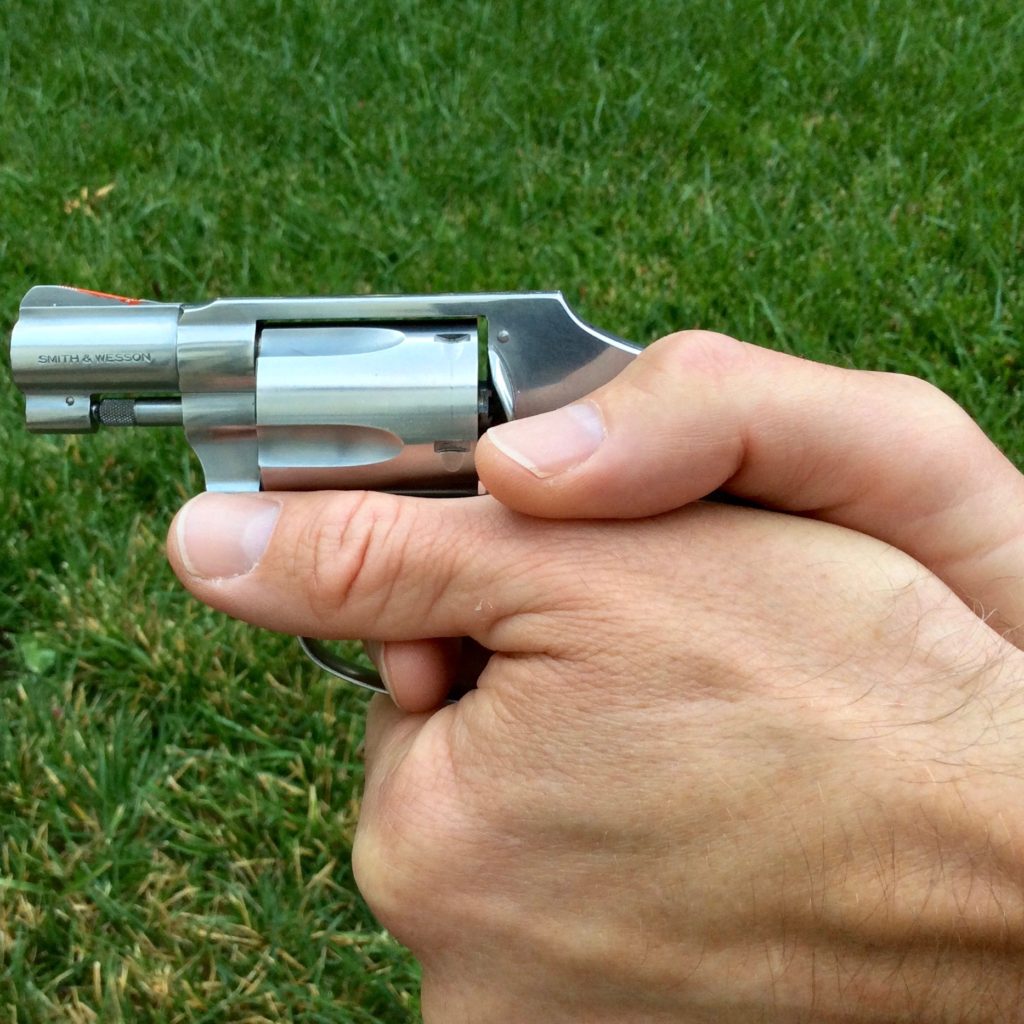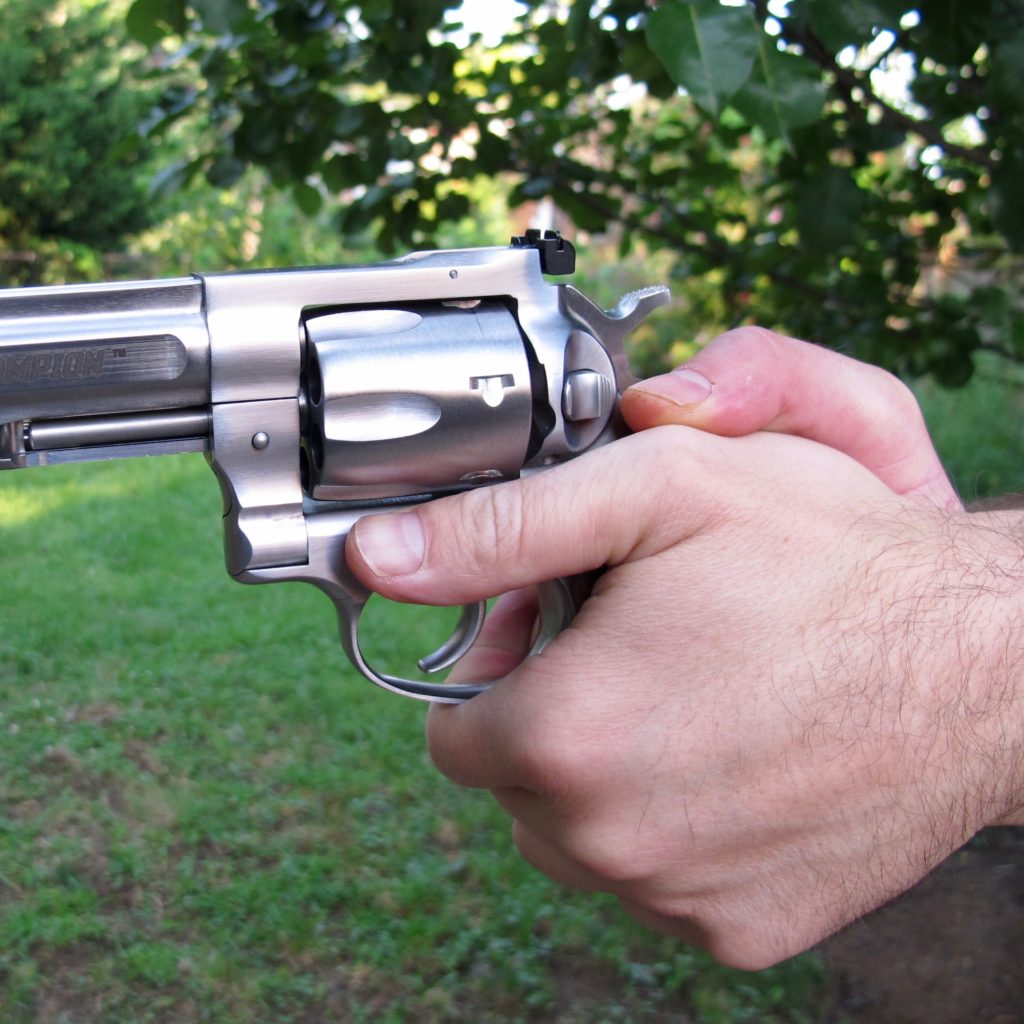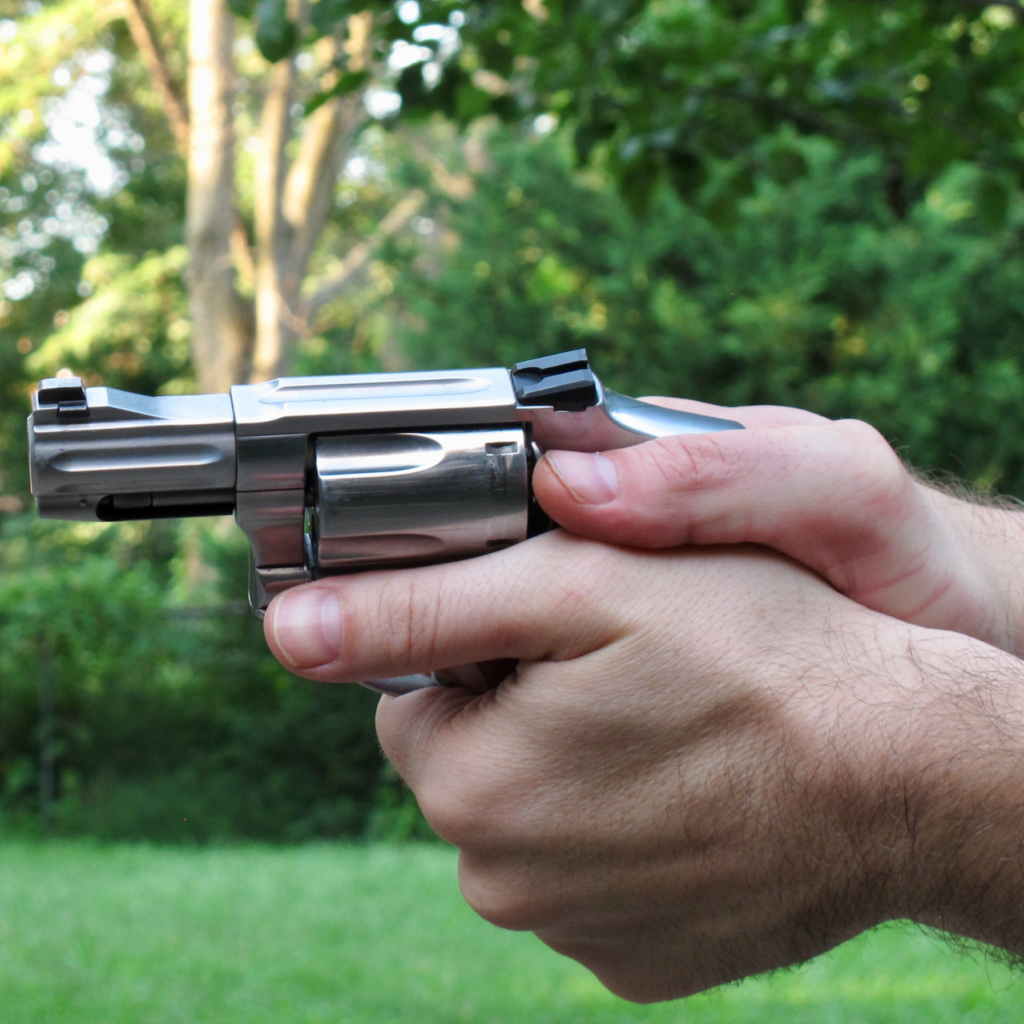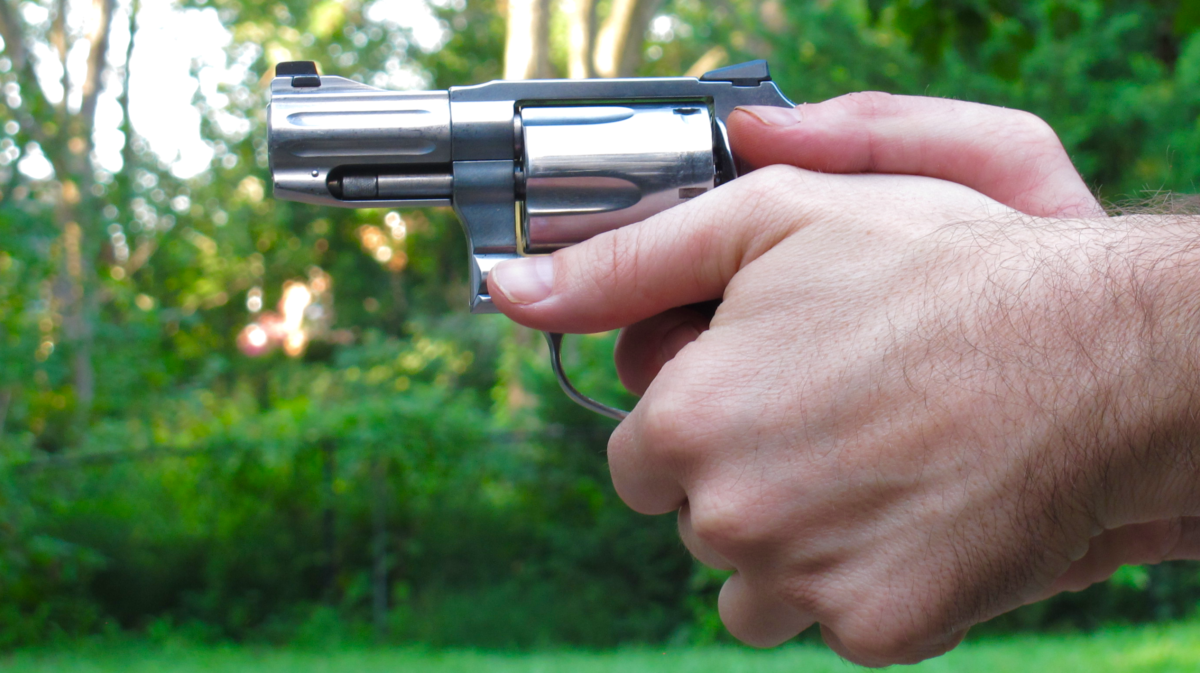As regular readers here know, I’ve taken up the revolver only recently. In years past I’ve carried the Beretta M9, the MEU(SOC) .45 1911, and the Glock 17 and 19 in harm’s way. I’ve invested hundreds of hours of training on these platforms, both at work and at my own expense. So when I made the switch from flat guns to round ones I tried to bring some of that knowledge with me, including how I grasp the gun. It turns out that I didn’t know what I didn’t know and inadvertently adopted the thumbs-forward revolver grasp.
Criticism of the Thumbs-Forward Revolver Grasp
My decision could have been drastically different. Had I done some research on the topic first, I might’ve adopted a proper revolver grasp. There is a lot of alarmism about shooting a revolver with a thumbs-forward grasp. If you watch this video from Hickok45 you’re led to believe that you are risking limb (if not life) if your thumb ventures anywhere forward of the recoil shield. The reason is that hot gasses escaping through the cylinder gap have the potential to injure the straying digit.
Fortunately for me, my thumb isn’t made of a folded paper target as depicted in the video. The worst effect I’ve had from shooting with this grasp is a blacked thumb at the end of the shooting session, with everything from the mildest .38 wadcutters to the romping, stomping Magnums. My experience doesn’t seem to be peculiar, either.
Does that mean you should be cavalier about your thumb placement on a revolver? Absolutely not! In heavier calibers (the 40-something through .500 Magnums, for instance) I would be extremely cautious about the placement of my thumbs in relation to the cylinder gap. Todd Brown is an example of what can happen with the heavier magnums. Mr. Brown lost 1/3 of his thumb shooting a .460 Magnum, and later sued Smith & Wesson for his trouble. The larger the caliber and the hotter the cartridge, the more gas that escapes. This translates directly to an increased risk of injury.

There are also a couple of other instances in which you should exercise a little more caution. If you have exceptionally large hands (like Mike Wood, shown above) and are shooting a very small revolver, it is possible for the thumb to get dangerously close to the forcing cone area of the frame-window. Likewise if you are shooting an oddball like the Chiappa Rhino, with its forcing cone on the bottom of the frame window. This places the thumb very, very close to the forcing cone. Caution is recommended.
Praise for the Thumbs-Forward Revolver Grasp
Personally, I find that there are a couple of things I happen to like about the thumbs-forward revolver grasp. The first is interchangeability with semi-autos. I know that statement borders on sacrilege here on RevolverGuy (this blog is about revolvers, isn’t it?) but some of you carry semi-autos on duty or for defense and shoot your wheelies only recreationally. If so, having two distinctly different grasps can be confusing (on both platforms) and doesn’t lead to strong myelinization of your neural pathways.

Secondly, the thumbs-forward revolver grasp gives me good control of the revolver. Better control, in my opinion, than either of the more traditional revolver grasp techniques. Much like shooting a semi-auto handgun, I roll my elbows outward which forces the palms together. This doesn’t work as well with the thumbs-tucked technique because the meaty portions of the palm don’t connect up, and I feel I end up mostly relying on finger strength alone. With the thumbs-forward grasp I’m actually pinching it between the meaty portions of my palms, and get meat all the way around the grip. In my opinion, this helps with managing recoil and contributes to faster follow-ups.

The Bottom Line
If there’s one thing I hate it is broad, overly-generalized, sweeping statements. “If you put your thumbs forward you will injure yourself,” is an example of such a statement. Remember my buddy’s kid I mentioned in the squib load article? After having seen a bunch of these videos he was afraid to shoot my 686. He will happily blast away with his dad’s Glock all day, but I had to coax him into shooting my revolver because this has, I feel, been blown somewhat out of proportion. He’s seen the YouTube videos and is scared of revolvers. Which is a real bummer.
If you aren’t comfortable shooting with a thumbs forward revolver grasp, I’m not saying you need to run out and try it. But… maybe we could tone down the “you’re gonna shoot your thumb off, kid” rhetoric just a bit? I know at least one or two of you guys out there use a thumbs-forward revolver grasp. What about the rest of you? Weigh in with a comment and let us know!


I shoot all of my revolvers thumbs forward, from snubbies to full size magnums, and have never had an issue. I also think this another “internet issue” blown out of proportion. Love your site.
Thanks,Dave
Dave,
The feedback is much appreciated, as are the kind words!
Justin
After the trial began, Todd Brown’s lawyers made an oral motion to dismiss the case. Whether there was a private settlement or whether he just folded is a matter for speculation.
I often shoot at an indoor range. The flash out of the barrel-cylinder gap with decently-charged centerfire ammunition is enough to persuade me to keep my thumb away from that.
Great post.
As you pointed out, I would never do this with a Rhino or Mateba, but those are the only two barrel-on-the-bottom revolvers I know of. Since I don’t own anything larger than a .357, I also don’t have to worry about the power level as much.
I was curious about the viability of some of the light mounting solutions for revolvers, and noticed that most require you to reach past the bottom front of the cylinder to reach the light controls. Having read about and seen hideous pictures of injuries in larger caliber guns, I decided to test it in my .357. I folded a piece of paper over a dowel and held it along the frame when firing. The result was a dirty piece of paper, but it didn’t tear the paper in my case. I then tried it with a gloved hand, and didn’t see any damage to the glove; it was just dirty. After that, I gave it a shot with my bare hand. I did feel some powder hit my hand (it felt like fine grains of sand hitting me), but it didn’t hurt, and I was not injured. Since I don’t shoot that way often (it was just a test to satisfy curiosity), I found the powder hitting me a minor distraction, but that was the worst of it.
I agree that it is still worth informing people of the risk, but it tend to get blown out of proportion. Kind of like the appendix carry concerns were a few years ago.
— Greyson
Interesting. I’ve been shooting weak hand thumb forward for about two years now. I used to shoot thumbs curled down, but after 50 years of farm work my left thumb has arthritis at the base, making it painful to curl it over the right thumb. So I switched to left thumb straight. I grip the gun in my right hand as if to shoot it one-handed, lift the right thumb, slide the left hand into place with the thumb straight along the frame between the trigger and cylinder, applying pressure inward. Drop the right thumb down on top of the left and curl down and inward to reinforce the left thumb. For me, moving the left thumb forward to the vicinity of the trigger helps to counteract the tendency for fast double-action trigger-pulls to shove the sights to the left. I’m getting better results.
Obviously the big question is hand size. My glove size is L (large). From the photos you guys must be XL or XXL. Your thumbs extend much farther forward than mine. On the SP101 the tip of my left thumb is just about the halfway point of the cylinder. On the GP100 it comes at the rear edge of the cylinder flutes. On the Super Redhawk it is at the front edge of the cylinder notches. My right thumb lies below the cylinder release, the tip in line with the cylinder loading gate gap.
I’m confused by the GP100 photo. The left thumb is all the way to the front of the cylinder, let’s attribute that to hand size. But the right thumb appears to be behind the recoil shield, a good inch rearward from my grip. This may be different grip angles (I shoot the rubber/insert grips), or we may just use completely different strong hand grips. You shoot semi-autos and I don’t so that could account for it. This is definitely not a one size fits all area.
Lee,
I have pretty small hands (at least compared to that Mike Wood character!). I’d put my glove size in the small-to-medium range. The GP100 picture has got to be attributed to the grip angle of the gun – it looks weird even to me.
Thanks for writing in!
Justin
“Exceptionally large hands?” I don’t think so. Any smaller and my gloves wouldn’t fit properly. ; ^ )
I too, have used the thumbs forward grip on a revolver many times, even with tiny J-frames and +P+ .38s (shhh . . . don’t tell the manufacturer). I’ve had one minor scratch, but typically all I got was a little sting, some temporary redness like a minor sunburn, and a black thumb. Mostly just a black thumb.
The caution you gave about high pressure cartridges is important, because you really can hurt yourself with the big bores (in more ways than one–busted knuckles, hurt wrists, split foreheads–I’ve seen it all) if you don’t know what you’re doing.
I’d add one more caution–your gun needs to be in good repair to do this. If your gun is out of time, you can have spitting problems, and those high speed slivers could cut you up or get under your skin, which could ruin your day. I think this is what happened to me the time I got cut. It wasn’t a big thing, but even a small cut is best avoided.
I’ve seen some guys who were experienced self-chuckers, but revolver newbs, apply drag to the cylinder with the support side thumb when shooting thumbs forward. Usually that’s a self-correcting issue, but it’s something to look for if you’re going to experiment with this hold for the first time. Make sure the support side thumb is in a good place that won’t bind things.
I think your analysis is spot on, my friend. There are times when it’s appropriate and times when it’s not, and there’s a lot of folks hyping this up on the interwebs without good reason. The best thing to do is see how the gun fits your hands, and use some good sense. This technique will work just fine for a lotta folks.
Now, the thing we really need to be worried about is this Weaver Vs. Isosceles thing, because that stuff can get you killed right quick . . . ; ^ )
I’m fairly new to revolvers and had a hard time finding a grasp that didn’t feel “wrong.” Even the usual thumbs forward with the support thumb under the cylinder didn’t feel natural or like it provided enough leverage. Without scouring the annals of interweb, I ended up with a very high grasp (mimicking my autoloader) resting my support hand thumb over the top of the (S&W) cylinder latch and strong thumb over that. I’ve since come across warnings about inadvertent cylinder release with thumbs in this area; but it’s become natural for me, gives good leverage, and I’m at the point where nearly every draw comes up with the sights dead bang on. So I’m reluctant to give up this far in, especially since I’ve never come close to accidentally airing my revolver’s payload. Incidentally, it also keeps my thumbs away from the cylinder gap, which keeps my goofy habits transferable in the unlikely event I migrate up to .4-‘s.
Thanks for making this blog! It’s been an enjoyable and informative resource for aimless wheelgun neophytes like myself.
Jason, I’d be nervous about the cylinder release getting moved under recoil too, but if it’s working for you after extensive testing, that says a lot. Who’s to say what’s “correct?” Just make sure you do some rapid fire work with your carry ammo to proof the technique when the gun starts bucking around. A lot of techniques that work OK with target ammo or slow fire start to fall apart when duty ammo is used or the pace picks up. It’s also possible the technique may not transfer to the bigger guns with more recoil, so if you do move up to the bigger guns, pay attention to that.
But, if it’s working for you, then keep on doing it. What matters most is results.
Glad you’re enjoying the blog! I am too! Stick around, we’ve got plenty more to come.
Mike, you may have just unmasked the recipe to my success: recoil (or lack thereof). I currently only shoot .38’s from my 66-3 and even the zippiest +p’s are pretty sedate. Coupled with my skinny fingers, it means any forward pressure from my thumbs goes straight into the recoil shield and without any real force, leaving the latch pretty much alone. My airweight on the other hand, with which everything feels like a magnum, puts my thumbs higher up due to the smaller frame size and I haven’t had any problems there either.
I appreciate your advice/insights. I’ll start keeping an eye on things again, especially when shooting faster. I may also try out some magnum loads to see what that changes, but so far so good!
PS I’m glued – every Friday evening I start hitting the refresh button until Sunday or new post – whichever comes first.
Jason (and anyone else reading this),
I’m super busy right now so I might slow a little bit for the next few weeks. For that I apologize in advance, but stay tuned – there’s a lot more to come!
Justin
No pressure. This should be fun for you too, not another source of stress.
I’ll keep checking. When you post, it’ll be like a little slice of Christmas. When you don’t, I’ll put the smart phone down and do something else like hug the kids or read a book.
EWWWW RAHHH for two thumbs forward grip!
Honestly it’s the only way I have ever shot any gun, be it revolver or semi auto.
If I attempt to shoot by folding thumbs down, I lose valuable palm contact with my left (support) hand, and then I am constantly bobbling the gun to attempt to maintain proper grip control.
Honestly, each set of hands is different, and each person needs to diligently seek out their personal best option. Properly fitting the gun to a shooter’s hands is very often an overlooked factor. That’s where I chalk up a gold star for revolvers. Aftermarket grips will generally offer the shooter a chance to make the grip larger or smaller.
I agree with Ron… how a weapon fits one’s hands is probably more important than how it is actually grasped.
Like a tennis grip, or swinging a baseball bat, you have “conventional wisdom,” the common notion of how it’s supposed to be done… and then you have the reality of how everyone actually does it.
Most of us who shoot end up with all sorts of different firearms, with widely varying manual’s of arms. My philosophy is simply to adapt to each one, rather than trying to force fit a single, compromise solution that covers them all. I’m not confused when I go outside and choose between my manual-transmission truck, my automatic-transmission car, my tractor, my ATV, or one of my motorcycles. And I’m equally comfortable moving between single-action revolvers, double-action revolvers, 1911’s, Glocks, and long guns of every stripe. I’m sure most guys are.
Human beings are remarkably adaptive. Time and testing will reveal what works, and what doesn’t.
I think weapon grasp is even more fluid in a defensive context. Imagine a reload-under-fire scenario, a la Officer Pence in the Newhall Shooting*. You may have to get the gun back in action with such urgency that there is simply no time to reestablish proper grasp. In that dire moment there’s probably something to be said for not being wedded to perfection.
And I couldn’t agree more, Justin, that risk to an extended digit is way overblown.
There’s dogma. And then there’s wisdom.
* Speaking of the Newhall Shooting… Mike’s “Newhall Shooting – A Tactical Analysis” (http://amzn.to/2hIqAgm) is outstanding. Very much recommended!
“There’s dogma. And then there’s wisdom.”
AMEN!!! Some of the best words I have seen on an Internet blog/forum in forever.
Happy Thanksgiving to you all.
Great thoughts Jeff, and thank you for the kind words about the book–sincerely appreciated!
I agree, as others have pointed out, that it has more to do with the relationship between hand size, finger length/girth, and the size/dimensions of the revolver and the stocks.
To accommodate a box magazine, the grip frame of a semi-auto gun must be at least somewhat, well, box shaped, regardless of how many back straps the gun ships with. That’s where a revolver has a distinct advantage. Anything from huge, square-butt conversion, presentation stocks to those weird Ergo Grips, and everything in between can be fitted. Find what works for your particular combination, and just run that.
Personally, I use a support-hand thumbprint to the distal knuckle on the thumb of the shooting hand grip. For me, I feel this gives better control over a double action trigger. That, and it’s just the way I’ve been doing it for more than three decades. No more new tricks for this old dog. I can barely keep up with the needed software updates every 36 hours. Oops there’s another one. Gotta go. Time to restart…
Ha! Rod, don’t do the updates! Don’t you know they’ll just bog the machine down? ; ^ )
I’ve never been one for thumbs forward grasp… Don’t know why not. Your mention of rolling the elbows out, however, was a light bulb moment for me! Thank you and keep up the good work!
Thank you very much for your blog. I had come to the same conclusion regarding thumbs forward grip for revolvers. It is likely that this carry over from semi-autos is a step on the evolutionary ladder for wheel gun use. The problem of having the thumb in the cylindar gap becomes moot when using a k-frame or larger, as my thumb does not reach the gap. My solution is to solely use 357 size guns while using +p for defense and normal 38 special for competition.
I have most of the Chiappa Rhino collections, so I just can’t do this. I have personally seen shooter’s thumb got burnt in half.
Do you have any photos? Can you put me in contact with the shooter? I would loved to validate this.
Thanks